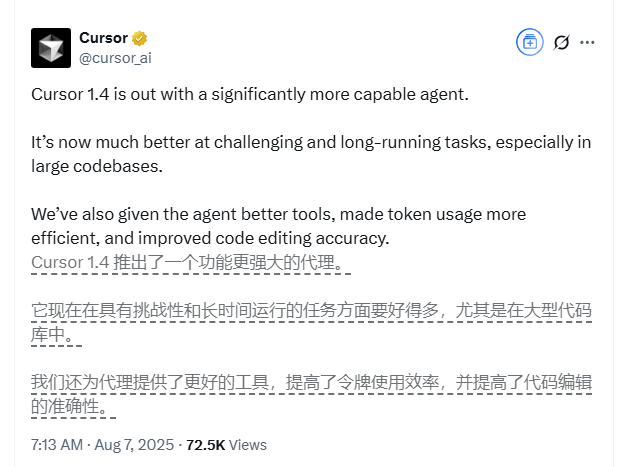On August 6, 2025, the AI code editor Cursor officially released its version 1.4, further solidifying its leading position in the field of AI-driven development tools. This update focuses on enhancing asynchronous and long-term task handling capabilities, especially in large codebases, providing developers with a more efficient and intelligent coding experience.

Significant Improvement in Asynchronous Task Handling
Cursor's version 1.4 has made significant breakthroughs in asynchronous task handling. According to the official announcement, the Agent feature has been greatly optimized, enabling it to handle complex and long-running tasks more efficiently. Developers can now smoothly start background Agents through natural language instructions, handling a variety of tasks from code generation to error fixing. Thanks to the optimized task queue management, developers can pre-schedule subsequent instructions while the Agent is executing the current task, significantly improving work efficiency.
In addition, Cursor 1.4 introduces more powerful background Agent tools, allowing Agents to run in independent remote environments. These Agents can clone GitHub repositories and work on separate branches, supporting seamless task handover. Developers can take over or review the progress of the Agent at any time. This asynchronous working mode is particularly suitable for large projects that require coordination across files or modules.
Precise Optimization for Large Codebases
For large codebases, Cursor 1.4 significantly improves the accuracy of code indexing and searching. By introducing a new embedding model, Cursor can better understand the project structure and context, thereby providing higher quality code completion and query results. Official data shows that the response time for code completion has been reduced by about 100 milliseconds, and the time to first token (TTFT) has decreased by 30%, thanks to the reconstruction of the memory management system and optimization of the data transmission path.
Additionally, Cursor 1.4 adds support for multi-root workspaces, allowing developers to index multiple codebases simultaneously. This is a major upgrade for developers who need to switch between different projects or handle complex dependencies. Combined with enhanced semantic search features, developers can quickly retrieve historical pull requests (PR), commit records, or issues, greatly accelerating post-mortem analysis and issue tracking.
Transition from Semi-Automatic to Fully Automatic
The release of Cursor 1.4 is not only a technical iteration but also signals a strategic shift of AI coding tools from semi-automatic to fully automatic. Earlier versions of the Cursor Agent mainly relied on developers providing detailed instructions and supervision, while the Agent in version 1.4 demonstrates stronger autonomy, capable of independently analyzing codebases, planning tasks, and performing complex modifications. This ability is due to the deep integration of large language models into the Agent mode, including optimized support for the Anthropic model and upcoming expansion to other models with search and replace tools.
The new version also introduces support for Jupyter Notebooks, allowing the Agent to directly create and edit multiple cells within a Notebook, offering more flexible tools for data science and research tasks. Additionally, the BugBot feature has been further enhanced, automatically reviewing PRs and providing detailed error feedback. Developers can directly jump to the editor to fix issues via the "Fix in Cursor" feature, significantly shortening the iteration cycle.
More Efficient Collaboration and Context Management
Cursor 1.4 further optimizes integration with GitHub and Slack, allowing developers to assign tasks, review code, or manage PRs directly through a browser or mobile device. The newly added context sharing feature allows team members to view and collaborate on the progress of Agent tasks, enhancing transparency in team collaboration. Additionally, the Memories feature is now fully available, allowing the AI to automatically record key decisions and context, and reuse them in subsequent sessions, reducing the need for repeated communication.
